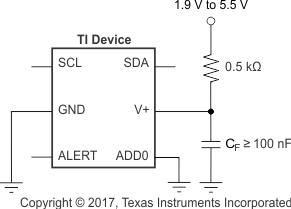SBOS740A May 2017 – May 2019 TMP116
PRODUCTION DATA.
- 1 Features
- 2 Applications
- 3 Description
- 4 Revision History
- 5 Pin Configuration and Functions
- 6 Specifications
-
7 Detailed Description
- 7.1 Overview
- 7.2 Functional Block Diagrams
- 7.3 Feature Description
- 7.4 Device Functional Modes
- 7.5
Programming
- 7.5.1 EEPROM Programming
- 7.5.2 Pointer Register
- 7.5.3 I2C and SMBus Interface
- 7.6
Registers Map
- 7.6.1
Register Descriptions
- 7.6.1.1 Temperature Register (address = 00h) [default reset = 8000h]
- 7.6.1.2 Configuration Register (address = 01h) [Factory default reset = 0220h]
- 7.6.1.3 High Limit Register (address = 02h) [Factory default reset = 6000h]
- 7.6.1.4 Low Limit Register (address = 03h) [Factory default reset = 8000h]
- 7.6.1.5 EEPROM Unlock Register (address = 04h) [reset = 0000h]
- 7.6.1.6 EEPROM1 Register (address = 05h) [reset = XXXXh]
- 7.6.1.7 EEPROM2 Register (address = 06h) [reset = XXXXh]
- 7.6.1.8 EEPROM3 Register (address = 07h) [reset = 0000h]
- 7.6.1.9 EEPROM4 Register (address = 08h) [reset = XXXXh]
- 7.6.1.10 Device ID Register (address = 0Fh) [reset = 1116h]
- 7.6.1
Register Descriptions
- 8 Application and Implementation
- 9 Power Supply Recommendations
- 10Layout
- 11Device and Documentation Support
- 12Mechanical, Packaging, and Orderable Information
Package Options
Refer to the PDF data sheet for device specific package drawings
Mechanical Data (Package|Pins)
- DRV|6
Thermal pad, mechanical data (Package|Pins)
Orderable Information
9 Power Supply Recommendations
The TMP116 operates on a power-supply range from 1.9 V to 5.5 V. The device is trimmed for operation at a 3.3-V supply, but can measure temperature accurately in the full supply range. A power-supply bypass capacitor is required, which must be placed as close as possible to the device. A recommended value for this supply bypass capacitor is 100 nF. Applications with noisy or high-impedance power supplies may require additional decoupling capacitors to reject power-supply noise.
The TMP116 is a very low-power device and generates low noise on the supply bus. Applying an RC filter to the V+ pin of the device can further reduce any noise that the TMP116 might propagate to other components. RF in Figure 44 must be less than 0.5 kΩ and CF must be at least 100 nF. Take care that the V+ pin voltage is not less than 1.9 V. The package thermal pad is not connected to the device ground and should be left unsoldered for the best measurement accuracy. If the thermal pad is soldered it must be left floating or connected to ground.
 Figure 44. Noise-Reduction Techniques
Figure 44. Noise-Reduction Techniques